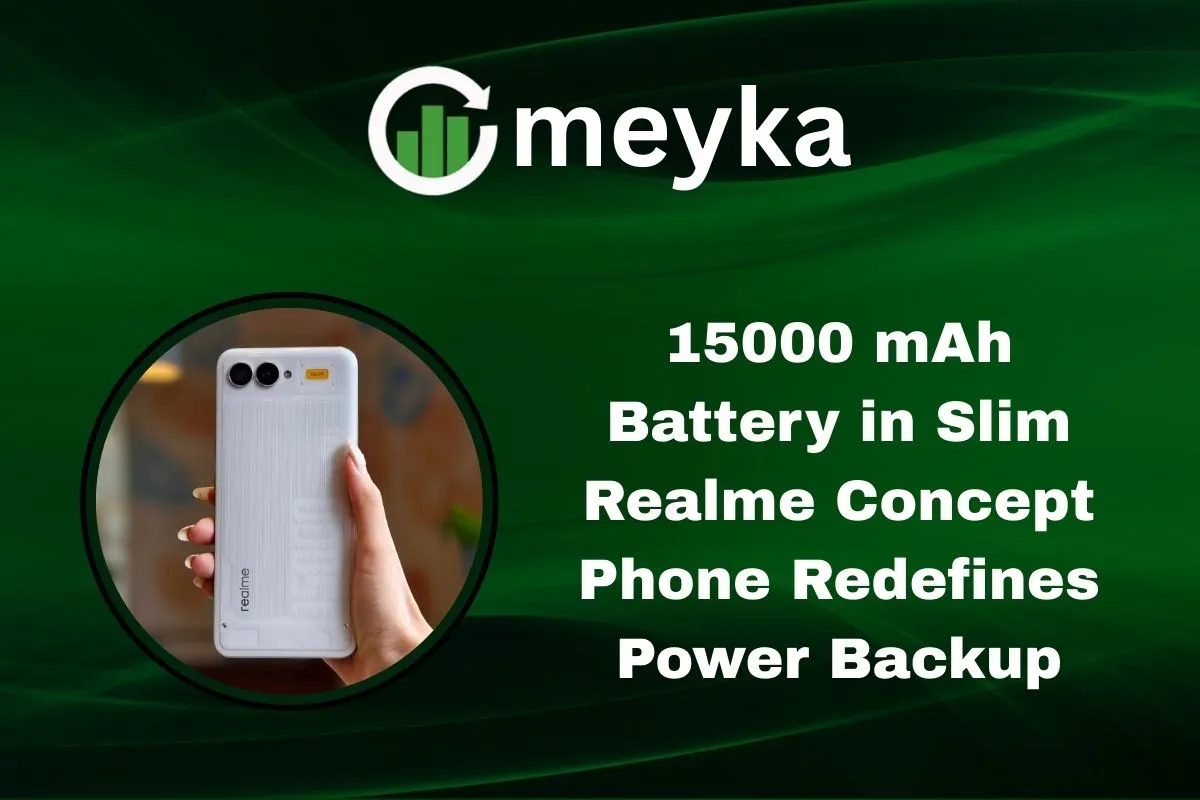15000 mAh Battery in Slim Realme Concept Phone Redefines Power Backup
Smartphones have become our daily partners. We use them for work, study, and entertainment, often all day long. But one constant worry remains: battery life. Most phones today have batteries around 4,000–6,000 mAh, which means many of us end up carrying power banks or frequently stopping to charge.
Realme has introduced an ambitious concept, a sleek smartphone equipped with a giant 15,000 mAh battery. This is not just another spec upgrade. It challenges our expectations of how long a phone can last and how slim it can be. If it works as advertised, it could be a real game-changer for people who hate being tied to a charger.
The Growing Demand for Power Backup
We all know the struggle: higher-resolution screens, 5G, video streaming, online gaming, video calls, these burn battery fast. As a result, long battery life has become one of the top must-have features for smartphone buyers, especially in markets where access to electricity can be unreliable.
Battery capacity has been creeping up, but consumers still report “battery anxiety”, the fear that your phone will die before you reach a charger. That’s why phones with bigger batteries are increasingly common. Still, the trade-off is usually a bulkier design or a heavier weight.
So when a brand promises both huge capacity and slim form, it grabs attention.
Realme’s 15,000 mAh Concept Phone: Key Highlights
Realme has shown off a concept phone with a 15,000 mAh battery, yet claims it stays under 9 mm thick.
Here are a few standout claims and features:
- Realme’s concept claims the phone can deliver up to five days of normal use, around 50 hours of video watching, or 30 hours of gaming.
- Forward-looking battery tech: Realme says the concept uses a 100% silicon anode battery. This helps increase energy density, allowing more power in the same space.
- Reverse charging and extreme use cases: The phone could act like a power bank, even powering small gadgets or devices via wired reverse charging.
Still, Realme says this is a concept phone, meaning it shows what might be possible, rather than what’s ready for mass production.
Design vs. Power: Breaking the Trade-Off
In the past, increasing battery capacity usually meant making phones thicker and heavier. Adding a big battery usually means adding thickness and weight. That’s one reason why many high-capacity phones are heavy.
What makes Realme’s concept notable is that it tries to maintain a slim profile while offering huge battery life. Realme’s use of advanced silicon-anode battery technology plays a big role here, as it allows for higher energy density. That means packing more juice without proportionally increasing battery size.
If the tech works well, this could help ease the typical trade-off between power and portability.
Impact on Smartphone Usage Habits
If Realme’s concept becomes a real product with similar specs, here’s how we might see users benefit:
- Fewer charges per day or per trip: Users could go multiple days without needing a charger. This reduces the need for carrying power banks or constantly searching for charging points.
- Longer streaming or gaming sessions: Watching videos or playing games for hours becomes much less stressful. For heavy users, this can drastically improve convenience.
- Better support for remote work or travel: In places with intermittent electricity, a long-lasting battery helps professionals, students, and travelers stay connected longer.
- Emergency backup: The phone itself could act as a backup power source for small devices, a big plus for outdoor or emergency situations.
- Lower need for add-ons: A phone that also works as a power bank saves us from carrying extra cables and adapters.
Realme’s concept even suggests the phone could power things like drones or small appliances via reverse wired charging, effectively blurring the line between phone and portable charger.
Market & Industry Implications
We from Realme, and likely other manufacturers, are paying attention to battery-life demands more than ever. As usage grows (especially video, gaming, and always-on connectivity), brands are under pressure to offer better battery backup without sacrificing sleek design.
Here’s why Realme’s concept has broader implications:
- It may push competitors to reconsider what’s possible with battery tech. If customers like the idea, we could see more phones with larger battery capacities, striving to stay slim.
- The battery arms race between brands might accelerate, especially in developing markets where battery life is a major buying factor.
- It reinforces the trend toward higher energy density materials (like silicon or silicon-carbon anodes, faster charging systems, better thermal management) that are more efficient and safer.
- From a sustainability view, if phones last longer between charges and reduce reliance on power banks, there may be less energy waste, though it also comes with new engineering and recycling challenges.
Challenges & Considerations
While the concept is exciting, we should also be realistic about potential hurdles:
- Scaling issues: The 100% silicon-anode battery used in Realme’s concept is not yet suitable for full-scale production. Silicon can expand and degrade over charge cycles, which raises longevity and safety issues.
- Heat management and charging speed: A big battery needs efficient cooling and fast but safe charging. If the phone heats too much during charge or heavy use, it may reduce battery life or risk overheating.
- Weight concerns: Even if the phone is slim, the added battery mass could make it feel heavier, affecting comfort and portability.
- Cost and pricing: Advanced battery tech tends to be expensive. If these costs are passed to consumers, the phone may become pricier than mass-market models.
- Safety and durability: If the technology is new, we need to see how the battery handles real-world usage over time, how it performs over hundreds of charging cycles, in heat, cold, or rough conditions.
Future of Smartphone Batteries
We think Realme’s concept underscores an important trend: battery innovation is finally catching up to other smartphone advances, things like camera sensors, chipsets, and AI.
Some key future directions include:
- Wider use of silicon-carbon or silicon-anode batteries: These promise higher energy densities and more efficient charging, enabling bigger capacities without extra size.
- Solid-state and next-generation chemistries: These are still in development but may offer even safer, higher-capacity options in slimmer profiles.
- Better thermal management: Advanced cooling systems, smarter charging algorithms, and AI-driven battery management will become more common.
- Improved energy efficiency: More efficient chipsets, display technologies, power-saving AI, and software optimization also play a critical role in extending real-world battery life without just increasing capacity.
- Sustainability and recycling: As battery technologies evolve, manufacturers are under more pressure to use eco-friendly materials and make better recycling systems.
In short, Realme’s 15,000 mAh concept is more than just a spec; it signals where the industry is headed.
Conclusion
The concept of a slim phone with a 15,000 mAh battery shows just how much room there still is for innovation in smartphones. If Realme can bring this from concept to reality without compromising safety, heat management, or price, it could redefine what people expect from power backup in a mobile device.
For users who hate daily charging, or who depend on their phones through long days, travel, or remote work, this kind of battery could mean fewer worries, fewer stops at the charger, and maybe even fewer carried accessories.
As we watch how Realme and other brands work on these challenges, one thing is clear: the future of smartphone battery life is shifting from incremental improvements to bold leaps. And that’s good news for all of us who just want a phone that lasts.
Disclaimer:
This content is for informational purposes only and is not financial advice. Always conduct your research.






